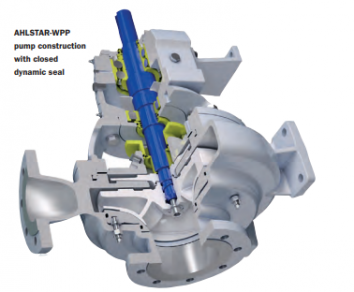- Home » Editorial » Hydraulics
Durable, energy-efficient slurry pump for phosphoric acid plant operations

By combining optimal hydraulics and wear-resistant materials of construction in a pump replacement, Sulzer has helped a leading phosphate fertiliser producer to increase productivity. H&P reports.
The Sulzer AHLSTAR WPP endsuction single-stage pump has demonstrated its effectiveness as a suitable choice, meeting performance requirements with notable advantages. Its efficient operation not only consumes less energy but also significantly reduces maintenance frequency
According to Hannu Makkonen, Head Tendering Support at Sulzer, the selection of wear-resistant hydraulics, a low operating speed, and proper material of construction for the wetted components could contribute to a considerable extension of the average pump lifetime in this very demanding position. This allows the customer to run the process without frequent interruptions.
Severe conditions for rotating equipment
Phosphoric acid is produced with a hemihydrate process, which is considered to be very severe for the rotating equipment installed in the reactor. The relatively high concentration of phosphoric acid and the presence of impurities combined with the elevated reaction temperature create a very aggressive environment.
The constraints for the slurry filter feed pump consist of multiple factors:
41% P2 O5 acid with corrosive contaminants (HF, H2 SiF6 , H2 SO4 , Cl-)
33% of solids (CaSO4 .0,5H2 O)
Presence of gas
Operating temperature 95-100°C
High total head (>30 m)
Low rated power
A slurry filter feed pump is in a very critical role at a phosphoric acid plant. A failure would have a direct deteriorating impact on the production rate of the plant, which is why robust and reliable equipment with the longest possible lifetime was considered to be of prime importance.
Sulzer selected an AHLSTAR WPP53-100 single-stage process pumps for the site. The WPP pumps are designed to be extremely wear-resistant and especially suitable for abrasive and erosive industrial applications. The series offers a comprehensive material selection, and the pumps can be tailored to suit the most demanding industrial applications with accessories such as shaft sealing solutions and heavy-duty bearing units.
The earlier pumps were made of a material that is very commonly used in phosphoric acid applications, CD4MCuN. This duplex stainless steel can give acceptable results in some applications of a dihydrate process, but it is not one of our solutions in a hemihydrate process. In this case, our preference was a higher-grade alloy, 654 SMO. This material, classified as 6%Mo super austenitic stainless steel, has an excellent resistance to corrosion by hot acid with a high chlorides content. It is more and more commonly used in the phosphate industry because it combines a very good resistance to corrosion and better erosion resistance than some more common austenitic stainless steels.
Increased durability
The previous pump at the site was rotating at a speed of around 1800 rpm, which is too high for this application. A pump with a low speed of rotation and a full-diameter impeller was sought after. An AHLSTAR WPP53-100 with a significantly bigger impeller diameter than in the previous pump was selected. Although the head is fixed, a lower rotation speed contributes to reduced wear. Other features adding to the prolonged lifetime of the pump are the wear-resistant design of a semi-open impeller and a casing fitted with a front wear plate.
-
PPMA 2025
23 September, 2025, 9:30 - 25 September, 2025, 16:00
NEC, Birmingham UK -
Advanced Engineering Show 2025
29 October, 2025, 9:00 - 30 October, 2025, 16:00
NEC, Birmingham UK










